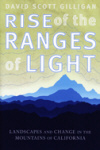Rise of the Ranges of Light
From a long tradition of nature writing that intermingles reflection and poetic descriptive prose with an ability to recount minute detail, David Scott Gilligan’s newest chronicle illuminates the California landscape. Gilligan juxtaposes first-person narrative with clear science writing as he explains geologic activity, volcanoes, and evolution, all focused on the diverse landscape of California mountain ranges. Following in John Muir’s footsteps, Gilligan endeavors to capture his personal connection to the landscape by employing stunning language to bring the Sierra Nevada to the reader.
From a long tradition of nature writing that intermingles reflection and poetic descriptive prose with an ability to recount minute detail, David Scott Gilligan’s newest chronicle illuminates the California landscape. Gilligan juxtaposes first-person narrative with clear science writing as he explains geologic activity, volcanoes, and evolution, all focused on the diverse landscape of California mountain ranges. Following in John Muir’s footsteps, Gilligan endeavors to capture his personal connection to the landscape by employing stunning language to bring the Sierra Nevada to the reader.
Thirteen chapters of independent yet overlapping essays cover a range of topics, all framed by Gilligan’s experience in the California outdoors. Each chapter begins in the tradition of such naturalists as Muir and Leopold, with Gilligan hiking and exploring the surrounding landscape. While he walks through the land, his vivid and highly descriptive prose soaks up each detail without feeling overwhelming; instead, we are drawn into the narrative through clear depictions of the lakes and mountains of the Sierra Nevada range. For example, in “The Stretching of North America,” he writes of lighting as a “seething conglomeration of energy that seems to meet my gaze with a hiss and displays a perfectly three-pronged bolt of its electric power.” The passages read both literary and seamlessly as scientific explanation for natural phenomena.
Gilligan presents the earth’s volatile geologic and evolutionary history with clear, concise prose that can be easily understood even by a novice ecologist. Although at times many of his descriptions overlap, and, by the final chapter, may become a bit repetitive, Gilligan manages to incorporate a multitude of information in the span of a few pages. In “Pleistocene Passion,” he describes glacier composition, saying, “Even deeper down are graceful layers of flowing, folded ice interspersed with neat calligraphic bands of black debris, both synclinal and anticlinal—evidence of hundreds of years of undecipherable action. Still deeper, a giant fallen serac protrudes from the abyss—a cryptic standing stone of silent ice.” The narrative style that frames these passages helps create a sense of balance in the chapters, which otherwise could be perceived as too descriptive or too scientific.
For anyone with interests in the changing American (and global) landscape, Rise of the Ranges of Light will not only help illustrate and explain these processes but will also provide a starting point of the aesthetic and spiritual experience of witnessing the land. Those unable to travel to the California landscape can at least glean some moments of insight from this well-rendered portrait of a mountain-scape teeming with life and complexity.





